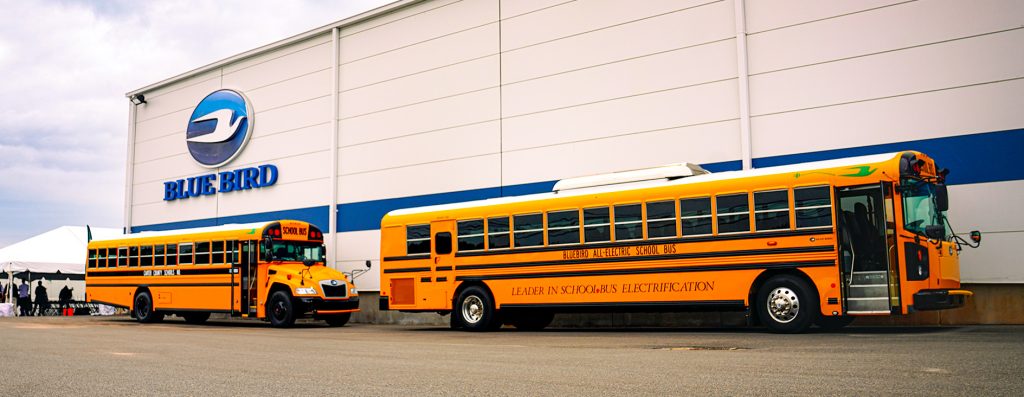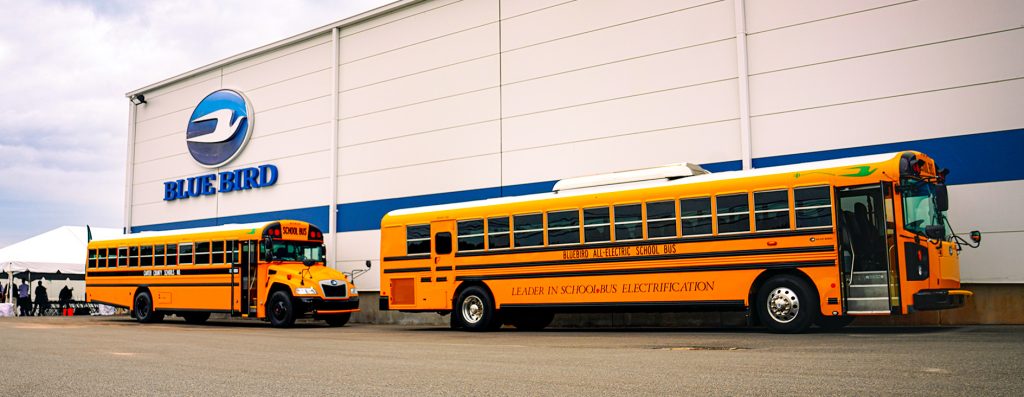Blue Bird Corporation (NASDAQ:BLBD) Sees Positive Analyst Sentiment and Growth in Alternative Fuel Buses

- The consensus price target for Blue Bird Corporation (NASDAQ:BLBD) has risen to $66, indicating increased optimism about the company's growth potential.
- Blue Bird's focus on alternative fuel buses and its strategic investments in production capacity are key drivers of its strong financial performance, including a record net sales revenue of $1.35 billion.
- Despite a low forward EV/EBITDA of 6.7 times, analysts see a significant upside in Blue Bird's stock, supported by a substantial order backlog and a market capitalization of $1.5 billion.
Blue Bird Corporation (NASDAQ:BLBD) is a prominent player in the school bus manufacturing industry, with a rich history dating back to 1927. The company offers a wide range of school buses, including Type C, Type D, and specialty buses. Blue Bird is also a leader in alternative fuel applications, producing buses powered by propane, gasoline, compressed natural gas, and electricity. The company operates through two main segments: Bus and Parts, distributing its products through a network of dealers and directly to fleet operators and government entities.
The consensus price target for Blue Bird's stock has shown a significant upward trend over the past year. A year ago, the average price target was $58, which slightly decreased to $57 in the last quarter. However, in the past month, the average price target has risen to $66. This suggests increased optimism among analysts about Blue Bird's future performance and growth potential. As highlighted by Zacks, the company's strong financial health, marked by record profits and zero debt, supports this positive sentiment.
Blue Bird's strategic focus on alternative fuel applications is a key factor driving this optimism. The company has made substantial investments to expand its production capacity, particularly in alternative fuel buses. This positions Blue Bird to benefit from regulatory support and growing demand for environmentally friendly transportation solutions. The company's recent achievement of record net sales revenue of $1.35 billion, a 19% increase from the prior year, underscores its strong market presence and financial performance.
Despite trading at just 6.7 times its forward EV/EBITDA, which is lower than the industry median, Blue Bird presents a compelling entry point for investors. The company's valuation is considered attractive, with analysts suggesting a potential upside of 47%. Blue Bird's significant order backlog further indicates sustained demand for its products, reinforcing its strong market position. As noted by Roth Capital analyst Craig Irwin, the stock's fair value suggests potential upside, with a price target of $29.
Investors and stakeholders should monitor upcoming company news and earnings reports, as these could further influence Blue Bird's stock target price. The company's recent government grant, aimed at increasing production capacity by 40% over the next two years, highlights its commitment to growth and innovation. With a market capitalization of $1.5 billion, Blue Bird continues to be a leader in the design, engineering, production, and sale of school buses across the United States, Canada, and internationally.
| Symbol | Price | %chg |
|---|---|---|
| 005389.KS | 197900 | -2.32 |
| 005380.KS | 268500 | -2.79 |
| 005385.KS | 198000 | -2.78 |
| 005387.KS | 200000 | -3 |

Blue Bird Corporation's (NASDAQ:BLBD) Earnings Overview
- Blue Bird Corporation (NASDAQ:BLBD) reported an EPS of $0.731, surpassing the estimated $0.65.
- The company's revenue for the quarter was approximately $350.2 million, exceeding the estimated $346.6 million.
- Financial ratios such as a P/E ratio of 13.13 and a price-to-sales ratio of 1.03 indicate the market's valuation of Blue Bird's earnings and sales.
Blue Bird Corporation (NASDAQ:BLBD) is a prominent manufacturer of school buses, particularly known for its focus on electric and cleaner-emission models. The company operates within the Zacks Automotive - Domestic industry, competing with other vehicle manufacturers. Blue Bird's commitment to innovation in the transportation sector has positioned it as a leader in the market.
On November 25, 2024, Blue Bird reported earnings per share (EPS) of $0.731, surpassing the estimated $0.65. This performance highlights the company's ability to exceed expectations, as it has done in three of the last four quarters. Despite a slight miss on the Zacks Consensus Estimate of $0.78, the EPS still showed improvement from the previous year's $0.66.
Blue Bird's revenue for the quarter was approximately $350.2 million, exceeding the estimated $346.6 million. This achievement marks a 4.54% increase over the Zacks Consensus Estimate and demonstrates consistent growth from the previous year's revenue of $302.96 million. The company has consistently surpassed consensus revenue estimates over the past four quarters.
Financially, Blue Bird maintains a price-to-earnings (P/E) ratio of 13.13 and a price-to-sales ratio of 1.03. These metrics indicate the market's valuation of the company's earnings and sales. The enterprise value to sales ratio is 1.01, suggesting a similar valuation when considering debt and cash. The enterprise value to operating cash flow ratio is 14.79, reflecting cash flow efficiency.
The company's financial health is further supported by a debt-to-equity ratio of 0.60, indicating moderate debt levels. A current ratio of 1.37 shows Blue Bird's ability to cover short-term liabilities with short-term assets. The earnings yield of 7.61% provides insight into the return on investment for shareholders, highlighting the company's profitability.

Blue Bird Corporation's (NASDAQ:BLBD) Earnings Overview
- Blue Bird Corporation (NASDAQ:BLBD) reported an EPS of $0.731, surpassing the estimated $0.65.
- The company's revenue for the quarter was approximately $350.2 million, exceeding the estimated $346.6 million.
- Financial ratios such as a P/E ratio of 13.13 and a price-to-sales ratio of 1.03 indicate the market's valuation of Blue Bird's earnings and sales.
Blue Bird Corporation (NASDAQ:BLBD) is a prominent manufacturer of school buses, particularly known for its focus on electric and cleaner-emission models. The company operates within the Zacks Automotive - Domestic industry, competing with other vehicle manufacturers. Blue Bird's commitment to innovation in the transportation sector has positioned it as a leader in the market.
On November 25, 2024, Blue Bird reported earnings per share (EPS) of $0.731, surpassing the estimated $0.65. This performance highlights the company's ability to exceed expectations, as it has done in three of the last four quarters. Despite a slight miss on the Zacks Consensus Estimate of $0.78, the EPS still showed improvement from the previous year's $0.66.
Blue Bird's revenue for the quarter was approximately $350.2 million, exceeding the estimated $346.6 million. This achievement marks a 4.54% increase over the Zacks Consensus Estimate and demonstrates consistent growth from the previous year's revenue of $302.96 million. The company has consistently surpassed consensus revenue estimates over the past four quarters.
Financially, Blue Bird maintains a price-to-earnings (P/E) ratio of 13.13 and a price-to-sales ratio of 1.03. These metrics indicate the market's valuation of the company's earnings and sales. The enterprise value to sales ratio is 1.01, suggesting a similar valuation when considering debt and cash. The enterprise value to operating cash flow ratio is 14.79, reflecting cash flow efficiency.
The company's financial health is further supported by a debt-to-equity ratio of 0.60, indicating moderate debt levels. A current ratio of 1.37 shows Blue Bird's ability to cover short-term liabilities with short-term assets. The earnings yield of 7.61% provides insight into the return on investment for shareholders, highlighting the company's profitability.

Blue Bird Corporation (NASDAQ:BLBD) Sees Positive Analyst Sentiment and Growth in Alternative Fuel Buses
- The consensus price target for Blue Bird Corporation (NASDAQ:BLBD) has risen to $66, indicating increased optimism about the company's growth potential.
- Blue Bird's focus on alternative fuel buses and its strategic investments in production capacity are key drivers of its strong financial performance, including a record net sales revenue of $1.35 billion.
- Despite a low forward EV/EBITDA of 6.7 times, analysts see a significant upside in Blue Bird's stock, supported by a substantial order backlog and a market capitalization of $1.5 billion.
Blue Bird Corporation (NASDAQ:BLBD) is a prominent player in the school bus manufacturing industry, with a rich history dating back to 1927. The company offers a wide range of school buses, including Type C, Type D, and specialty buses. Blue Bird is also a leader in alternative fuel applications, producing buses powered by propane, gasoline, compressed natural gas, and electricity. The company operates through two main segments: Bus and Parts, distributing its products through a network of dealers and directly to fleet operators and government entities.
The consensus price target for Blue Bird's stock has shown a significant upward trend over the past year. A year ago, the average price target was $58, which slightly decreased to $57 in the last quarter. However, in the past month, the average price target has risen to $66. This suggests increased optimism among analysts about Blue Bird's future performance and growth potential. As highlighted by Zacks, the company's strong financial health, marked by record profits and zero debt, supports this positive sentiment.
Blue Bird's strategic focus on alternative fuel applications is a key factor driving this optimism. The company has made substantial investments to expand its production capacity, particularly in alternative fuel buses. This positions Blue Bird to benefit from regulatory support and growing demand for environmentally friendly transportation solutions. The company's recent achievement of record net sales revenue of $1.35 billion, a 19% increase from the prior year, underscores its strong market presence and financial performance.
Despite trading at just 6.7 times its forward EV/EBITDA, which is lower than the industry median, Blue Bird presents a compelling entry point for investors. The company's valuation is considered attractive, with analysts suggesting a potential upside of 47%. Blue Bird's significant order backlog further indicates sustained demand for its products, reinforcing its strong market position. As noted by Roth Capital analyst Craig Irwin, the stock's fair value suggests potential upside, with a price target of $29.
Investors and stakeholders should monitor upcoming company news and earnings reports, as these could further influence Blue Bird's stock target price. The company's recent government grant, aimed at increasing production capacity by 40% over the next two years, highlights its commitment to growth and innovation. With a market capitalization of $1.5 billion, Blue Bird continues to be a leader in the design, engineering, production, and sale of school buses across the United States, Canada, and internationally.







